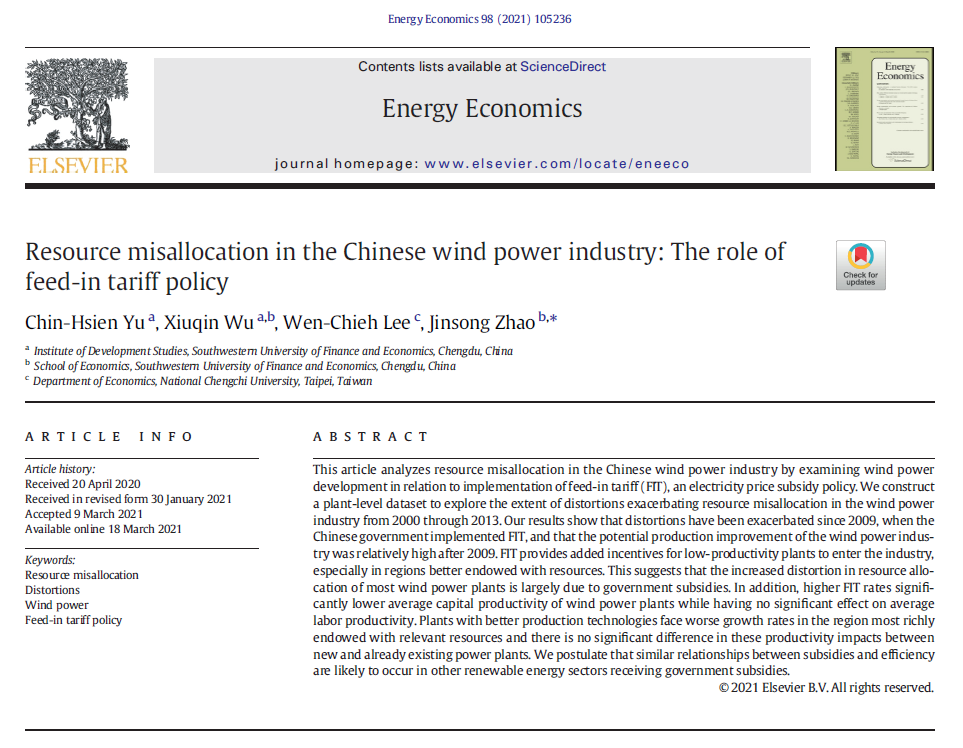我院余津嫺等的论文:Resource Misallocation in the Chinese Wind Power Industry: The Role of Feed-in Tariff Policy 在《能源经济学》(Energy Economics)发表。

我院余津嫺副教授与其博士研究生吴秀琴、台湾政治大学李文傑副教授、经济学院赵劲松副教授合作,于国际知名期刊《能源经济学》(Energy Economics)发表论文《Resource misallocation in the Chinese wind power industry: The role of feed-in tariff policy》。该文借鉴Hsieh & Klenow(2009)的资源错配模型,使用工业企业数据库2000-2013年的数据,讨论了政府产业扶持政策对资源错配的影响。研究发现对企业提供电价补贴的标杆电价(FIT, feed-in tariff)政策加剧了风电行业的资源错配,从而降低了风电行业的生产率。该文的主要贡献有以下几点:首先,在错配模型设定中,该文在Hsieh & Klenow(2009)的资源错配模型基础上,将规模报酬不变假设放宽为规模报酬递减,使模型设定更符合风电行业。进一步地,该文通过反事实分析分解了行业总产出的变化,可以更好地计算错配的来源。其次,以往关于提高可再生能源行业生产率的研究多集中于提升技术效率方面,该文从生产资源配置角度展开讨论,弥补了相关研究空白。第三,在理论模型的基础上,该文利用中国工业企业数据库中的风电企业数据,考察了标杆电价(FIT, feed-in tariff)政策对风电行业资源错配的影响以及错配存在的潜在原因,进而为中国风电行业的未来发展提出政策建议。该分析框架具有一般性,因此同样适用于其他大力发展可再生能源的国家。第四,关于产业政策作用的争论由来已久,该文通过评估产业政策对中国风电产业资源错配的影响,为这一争论做出了贡献。
余津嫺博士是西南财经大学发展研究院的副教授、博士生导师,主要研究方向为气候变迁、自然资源与环境、能源、农业经济与自然灾害等跨学科交叉领域研究。余津嫺博士的研究成果主要发表于《Energy Economics》、《Energy Policy》、《Renewable and Sustainable Energy Reviews》、《International Review of Economics and Finance》、《Society & Natural Resources》、《Safety Science》、《Natural Hazards》等国际知名学术刊物上,担任多篇国际期刊论文审稿人。
论文摘要:
This article analyzes resource misallocation in the Chinese wind power industry by examining wind power development in relation to implementation of feed-in tariff (FIT), an electricity price subsidy policy. We construct a plant-level dataset to explore the extent of distortions exacerbating resource misallocation in the wind power industry from 2000 through 2013. Our results show that distortions have been exacerbated since 2009, when the Chinese government implemented FIT, and that the potential production improvement of the wind power industry was relatively high after 2009. FIT provides added incentives for low-productivity plants to enter the industry, especially in regions better endowed with resources. This suggests that the increased distortion in resource allocation of most wind power plants is largely due to government subsidies. In addition, higher FIT rates significantly lower average capital productivity of wind power plants while having no significant effect on average labor productivity. Plants with better production technologies face worse growth rates in the region most richly endowed with relevant resources and there is no significant difference in these productivity impacts between new and already existing power plants. We postulate that similar relationships between subsidies and efficiency are likely to occur in other renewable energy sectors receiving government subsidies.
文章来源: Yu, C.H., X. Wu, W.C. Lee, J. Zhao* (2021). Resource Misallocation in the Chinese Wind Power Industry: The Role of Feed-in Tariff Policy. Energy Economics, 98, 105326. https://doi.org/10.1016/j.eneco.2021.105236.
 扫一扫关注我们
扫一扫关注我们